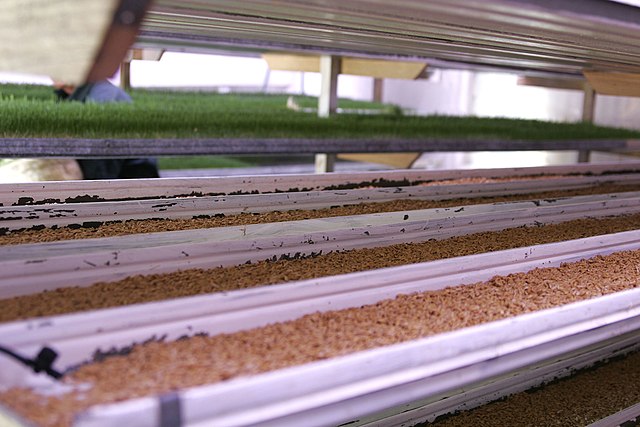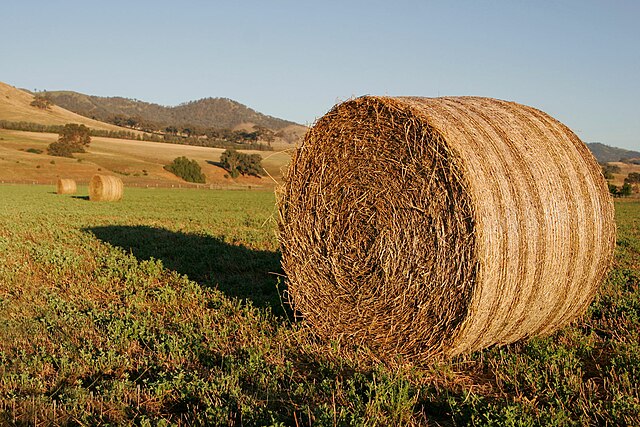Loading AI tools
Agricultural foodstuff used to feed domesticated animals From Wikipedia, the free encyclopedia
Fodder (/ˈfɒdər/), also called provender (/ˈprɒvəndər/), is any agricultural foodstuff used specifically to feed domesticated livestock, such as cattle, rabbits, sheep, horses, chickens and pigs. "Fodder" refers particularly to food given to the animals (including plants cut and carried to them), rather than that which they forage for themselves (called forage). Fodder includes hay, straw, silage, compressed and pelleted feeds, oils and mixed rations, and sprouted grains and legumes (such as bean sprouts, fresh malt, or spent malt). Most animal feed is from plants, but some manufacturers add ingredients to processed feeds that are of animal origin.
This article needs additional citations for verification. (October 2014) |

The worldwide animal feed trade produced 1.245 billion tons of compound feed in 2022 according to an estimate by the International Feed Industry Federation,[1] with an annual growth rate of about 2%. The use of agricultural land to grow feed rather than human food can be controversial (see food vs. feed); some types of feed, such as corn (maize), can also serve as human food; those that cannot, such as grassland grass, may be grown on land that can be used for crops consumed by humans. In many cases the production of grass for cattle fodder is a valuable intercrop between crops for human consumption, because it builds the organic matter in the soil.[citation needed] When evaluating if this soil organic matter increase mitigates climate change, both permanency of the added organic matter as well as emissions produced during use of the fodder product have to be taken into account.[clarification needed] Some agricultural byproducts fed to animals may be considered unsavory by humans.[citation needed]






In the past, bovine spongiform encephalopathy (BSE, or "mad cow disease") spread through the inclusion of ruminant meat and bone meal in cattle feed due to prion contamination. This practice is now banned in most countries where it has occurred.[citation needed] Some animals have a lower tolerance for spoiled or moldy fodder than others, and certain types of molds, toxins, or poisonous weeds inadvertently mixed into a feed source may cause economic losses due to sickness or death of the animals. The US Department of Health and Human Services regulates drugs of the Veterinary Feed Directive type that can be present within commercial livestock feed.[citation needed]


Increasing intensities and frequencies of drought events put rangeland agriculture under pressure in semi-arid and arid geographic areas. Innovative emergency fodder production concepts have been reported, such as bush-based animal fodder production in Namibia. During extended dry periods, some farmers have used woody biomass fibre from encroacher bush as their primary source of cattle feed, adding locally-available supplements for nutrients as well as to improve palatability.[8][9][10][11][12]
This section may be confusing or unclear to readers. (July 2021) |

Fodder in the form of sprouted cereal grains such as barley, and legumes can be grown in small and large quantities.
Systems have been developed recently[when?] that allow for many tons of sprouts to be produced each day, year round. Sprouted grains can significantly increase the nutritional value of the grain compared with feeding the ungerminated grain to stock.[13] In addition, they use less water than traditional forage, making them ideal for drought conditions. Sprouted barley and other cereal grains can be grown hydroponically in a carefully-controlled environment.[14] Hydroponically-grown sprouted fodder at 150 mm tall with a 50 mm root mat is at its peak for animal feed.
Although products such as barley are grain, when sprouted they are approved by the American Grassfed Association to be used as livestock feed.[citation needed]
Seamless Wikipedia browsing. On steroids.
Every time you click a link to Wikipedia, Wiktionary or Wikiquote in your browser's search results, it will show the modern Wikiwand interface.
Wikiwand extension is a five stars, simple, with minimum permission required to keep your browsing private, safe and transparent.